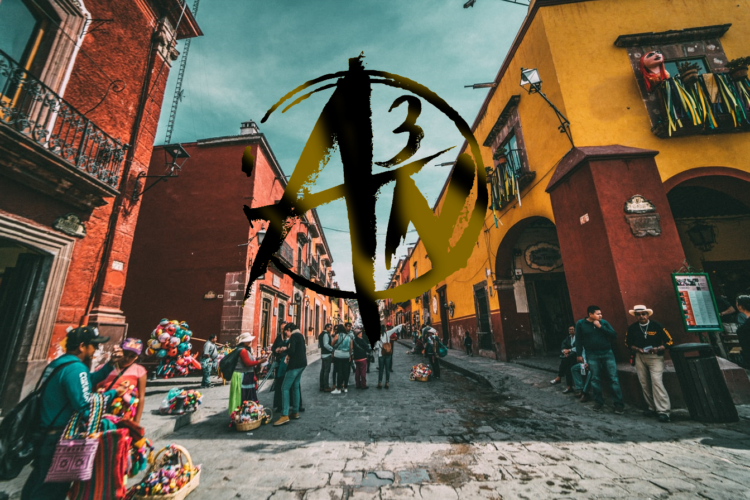
How to bug out to Mexico
Part of my motivation for becoming an agorist was to be prepared for any sort of collapse that may come about. The way I saw it 8 years ago was this: collapse of some kind (likely financial) was coming soon and I had no skills to exist in a world without government, even if that was the world I wanted. So my focuses were turned on learning skills that I could survive with, everything from firewood harvesting to urban farming.
Learning skills, gardening and preserving food and hunting are just some ways to hedge against any sort of collapse, but that’s actually not the point of this post. The point of this is to share another aspect of being an agorist in modern times I think people should pay more attention to.
Many agorists are very much the “I’m gonna stay here because I don’t run from problems” mindset when it comes to the United States. Those same agorists are freaking out right now, trapped in their own homes literally by the State thanks to Covid-19. There are aspects of this virus that are concerning for me (mostly legal stuff) but as a whole I’ve been okay and I would have to say the difference is the place.
This is a guide on how to bug out to Mexico if you want to as well as why you should sooner rather than later, if you’re going to at all. Travel restrictions have been being openly discussed and if the situation doesn’t dissolve soon, they’re likely to be imposed.
Why Mexico?
Mexico is known for being freer than the United States for reasons like lack of resources to control its citizens. There’s also a lot of tax and legal loopholes here uniquely Mexican. In regards to COVID-19, Mexico has been surprisingly chill. The only areas to really go on “lockdown” are places like Mexico City, which even just locked down very recently as I was there less than a month ago and things were pretty busy there still. The locals maintain that they can’t shut down the country, from my understanding there’s not really martial law here in the same way.
When I go out I see signs with the symptoms of COVID-19 like they had for ZIKA a few years ago in Acapulco. There’s some people with masks, most of them flimsy and more for show than anything. As the only white person in my area I am treated with respect even if I do get some funny looks now. In bigger cities nearby, I hear there are restrictions like limits on number of customers in the store at a time for big box stores. Markets are less populated but still functioning.
From what I can tell the most locked down places are areas like Acapulco and Puerto Vallarta. In Acapulco there’s military keeping people off the beaches, now even the deserted ones in areas like Bonfil. There is some panic shopping in bigger cities but not for stupid things like toilet paper, usually beans and rice type items.
Mexico is still incredibly cheap, more so actually currently because the current dollar to peso ratio because of COVID-19. I still go out on hikes but I also live in an area where there are few cops so I’m not likely to see anyone on those, let alone cops.
WHERE IN MEXICO
Avoid the tourist areas. If some gringo friend of yours recommended it, try anywhere else, preferably small mountain city that produces food. Tourist areas are the last place you want to be in true collapse, save those for if/when the crisis dissolves. In the event of a collapse you want farmers as neighbors not empty bars and restaurants and a bunch of desperate souvenir vendors. You’ll experience the most freedom in areas with small population. I have my own little slice of heaven I’m keeping private but there’s about a million other small towns you can try here.
HOW TO TRAVEL
According to the internet, plane travel is still an option there just may be tighter security precautions. However I recommend traveling by your own vehicle if you can. Having a vehicle, especially in small town Mexico, is extremely helpful. It’s also a lot of fun to drive here so for those who enjoy the sport of driving without having to deal with stupid things like tickets for too wide of a left turn, Mexico is for you.
When driving in Mexico you get a temporary permit for your car to be here during the duration of your visa. Of course you can forgo the permit and also the visa just know you’ll likely have to pay more in bribes and likely deal with harassment, especially in places like Acapulco. We lived for 3 years in Acapulco with no permit and got in more than 30 police chases, none of which ended badly. I will say though even if the chases were exhilarating I’d have rather not dealt with them at all, personally.
If you’re flying but want to make it cheaper consider a bus/plane route hybrid. So either bus to the border and fly the rest of the way or fly to TJ and bus wherever you want in Mexico. Mexico has extremely cheap and luxurious buses.
THINGS NEEDED
What you need depends on the person but some things are at least highly recommended. It’s worth pointing out if you try hard enough you can come here without some or even all of these things and be fine if you remain vigilant. Like passports for example, I have never had one so I live my life in a way to where I don’t need it. I have extra hoops to jump through, sure, but I also have a lot of freedom.
Money, Income: This is one thing I had very little of when I came here 4 years ago. 50 USD to be exact when we crossed the border. My life has been extremely difficult because of this so while you can come here with nothing, I don’t recommend it. You don’t have to have a huge savings but at least an online job that gets you 500 USD a month at a minimum. However if you’re a hard working person with a laptop, you can always get here first and worry about the job after just know you’ll have to hustle your ass off.
Vehicle: Useful for getting around, although there is country wide transportation for people even in the desert that is pretty cheap. Most useful for moving quickly, if you have to.
Passport/Papers: So yeah, another one I don’t follow but this one I wish I did. It’s pretty hard existing here without paperwork. If you have no other choice, do what you need, just know that it can get pretty frustrating. The good news is the fun stuff and quality of life makes the frustrations worth it, for me anyway.
Garden Seeds: I know this is a sore spot because apparently a virus makes vegetable seeds in the US to be an unessential item during these days. If you intend to start any kind of garden, bring as many seeds as you can because the seed collection in Mexico is surprisingly limited especially when it comes to things like heirloom varieties of…well anything.
Tools: There are tools here but sometimes there’s things in the US that are just a little higher quality (generally more expensive, too). When I moved to Mexico, we bought with us 2 Fiskars axes and a Fiskars Hatchet because we knew we wouldn’t be able to find them here. And we were right, 4 years in and I still have yet to see a Fiskars axe.
Cast Iron Anything: Most of Mexico is sadly void of good cast iron products, although they do jump up here and there in big box stores in cities. If you decide to flee to Mexico and you’ve got the space, don’t leave that cast iron behind. Of all the stuff I brought with me from the US (not much) the things I cherished most were my axes and my cast iron.
Spanish: This one’s intellectual but at least learning the basics will go a long way, especially at places like the market. Below I’ll include some survival Spanish tips for the modern day agorist.
Clearly anything else you bring is based on your own needs, these are just some things to consider.
THINGS I WISH I KNEW
Don’t Get Caught in the Tourist Trap: Something I’ve learned since leaving Acapulco is the fact that I so much prefer small towns in Mexico with none of the big hotels, clubs and restaurants. I didn’t realize how much Acapulco was catered to the needs of Americans until I left then returned for Anarchapulco. I now see Acapulco as Gringolandia, along with Mexico City. And in my opinion the best tourist areas aren’t the first ones that come to mind. They’re places like Taxco, Patzcuaro and Morelia.
Gas is WAY More Expensive In Mexico. You’d think being an oil producing country that Mexico would have cheap gas, but no. That’s because there’s no refineries here, everything is exported to be processed than reimported. This is something we didn’t expect until we went to the first gas station, did the math for the gallon of gas. If I remember correctly at the time it was nearly double the price that it was in California.
ALL of Mexico is Beautiful: I’ve been through a lot of the country at this point and I can’t say there’s an ugly part of Mexico as far as I’m concerned. There’s a quiet somber beauty to the desert, a gorgeous chaos to the jungles. When I came down the West Coast 4 years ago I was floored at the range of climates to be found within Mexico. This has only been reinforced by my recent travels.
SPANISH FOR THE MODERN DAY AGORIST
While it’s true you don’t have to speak Spanish to survive, it does go a long way at the market and with those you do business with. Locals always have more respect for you if you try and speak the language than if you just rely on Google Translate. One thing is for sure, if you just yell at them in English you’re going to get the gringo price which is often 4-10 times higher than the local price.
I’ve assembled a list of the essential terms to know in Spanish to have the best time you possibly can at the market, tailored for market and sales.
“Hola, Como Estas”-Hi, How are you?
It’s simple, most people know it yet it goes a far way in earning the respect of those you buy from.
“Cuanto Cuesta” How much does this cost?
One of the very first phrases I was taught when I went to the Central Market in Acapulco and is one of the phrases I still use most to this day. As an agorist, the most important thing is knowing the cost.
“Quiero mas barato” “I want it cheaper”: I’m gonna start by saying that I cant guarantee correct grammar on any of this because I’m still not fluent. But I can say that these phrases have worked to get me what I want in negotiations at the market and that’s really all that matters to me at this point. Sometimes they’ll show you cheaper options, others they’ll drop the price. Sometimes you’ll get them laughing at you. It’s always worth a try.
“Muy caro” Very Expensive.
This is a phrase you save for when you’re buying items that aren’t clearly marked with a price. Clothes and things like that are often left unmarked so they can charge you whatever they think you’ll pay. Some people dislike this, but its easy to get around the bullshit and still get things for at least close to the local price.
Note: If you have an object someone recommended where they told you the price and you find it in public, just ask if the item costs that much. This requires knowledge of the numbers, my next point. But if you toss the price out there, they’ll either agree or try and correct you with a higher price. There have even been times I got a lower price for doing that.
Numbers: There are clearly too many to list here. Duolingo does a good job of teaching numbers but you can learn them anywhere really. They’re some of the easiest words to encounter and the ones you will likely hear the most. It took only a few months of living here before I understood all of the numbers.
“Buen provecho” “Good Blessings/Health Ect”
This is commonly said while you’re eating. It took me 2 months of being in Acapulco eating at my friends restaurant to have people saying that to me before he explained what it meant. For manners when you go to a restaurant and you walk by others eating, you say Buen provecho or provecho. They usually return with Gracias (Thank you) which is what you should say if someone says it to you.
The thing to consider about Mexico is there’s a much higher agorist population here, and most don’t even know it. Most of these people know to exist on their own, many of them live off their land. If you can find yourself a food producing town you might find them supporting you instead of stealing from you like you’d have in the United States once things really start to get desperate. At the very least, Mexico is the perfect place to pass time where we are told we can’t do anything.







